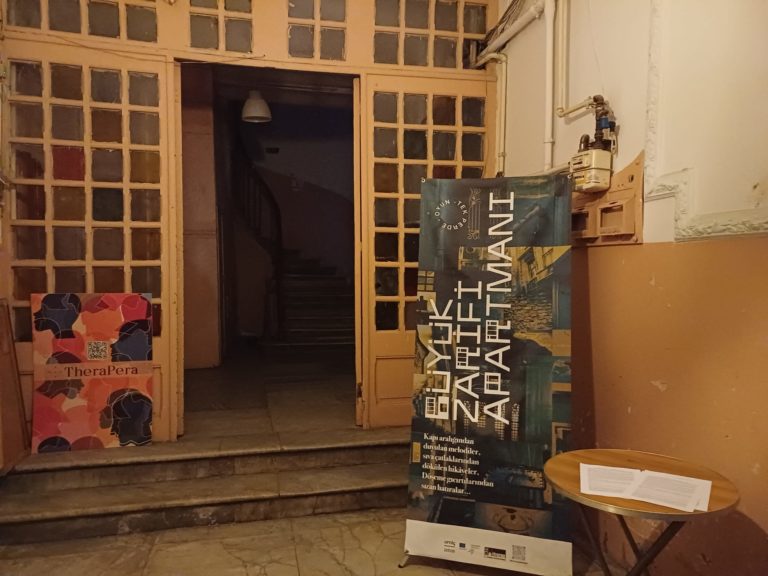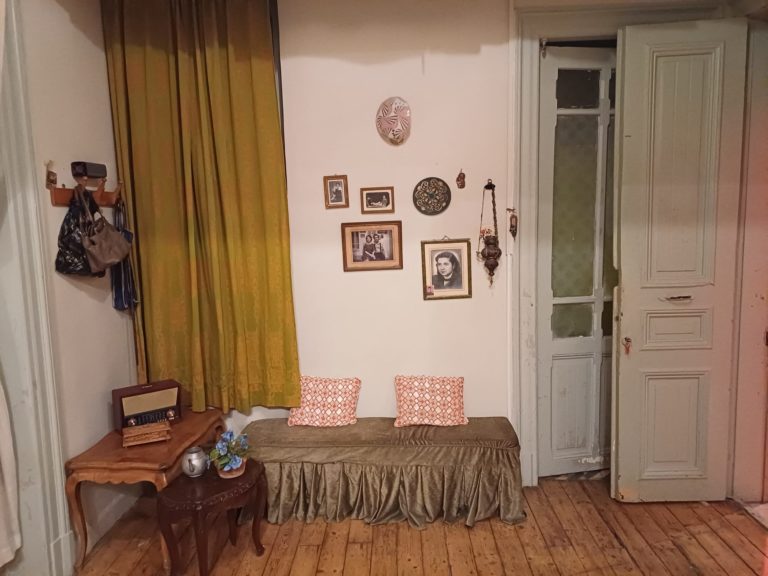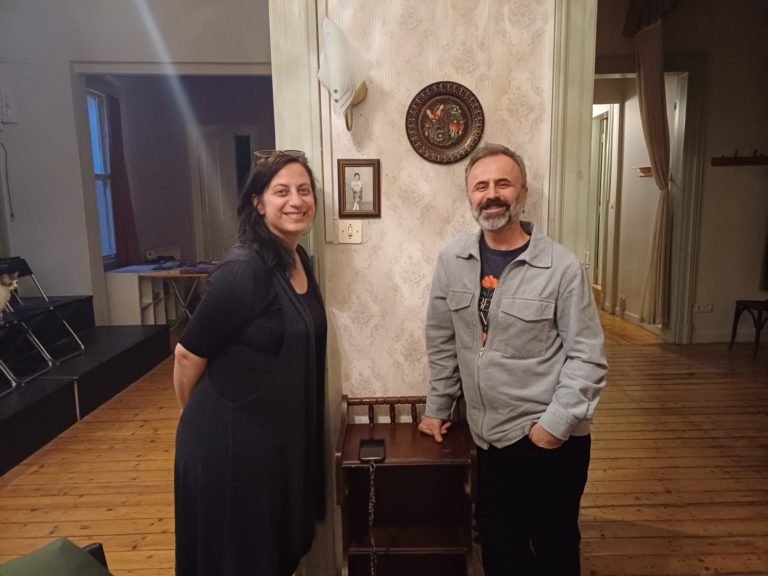Author: Ozan Doğan Avunduk
Over the past two decades, urbanisation and a neglect of cultural heritage exemplified by the closure of old theatre halls, cinemas, and bookstores led to the erosion of Istanbul’s cultural life. Today, concerns about Istanbul’s artistic and cultural landscape have intensified, particularly with the imprisonment of the opposition mayor and his culture team, renowned for their dedication to cultural and architectural preservation. Amidst increasing pressure on culture, a 150-year-old architectural gem “Grand Zarifi Building” stands as a symbol of resistance, safeguarding Istanbul’s multicultural identity and artistic life at the same time. On the building’s second floor repurposed as a stage, citizens reconnect with the city's diverse past through a moving play.

A Breath of Culture in Beyoğlu
In Istanbul, most plays are now staged on new and vast scenes owned by large companies. The historical district of Beyoğlu, once known for its thriving artistic life and cultural diversity, now predominantly displays the facades of retail stores, fast-food chains, and sprawling shopping centres. In the last 20 years, Beyoğlu’s cultural, artistic, and alternative urban life has undergone a dramatic metamorphosis, mirroring the transformation of the country itself, despite pockets of social resistance dating back to the 2013 Gezi Park protests. “Twenty years ago, people used to instinctively thought of Beyoğlu when seeking out theatre. That’s no longer the case,” observes İlyas Özçakır, the actor and director behind the Büyük Zarifi Apartmanı play (The Grand Zarifi Building in English). The shutting down of cultural landmarks such as the Emek Cinema built in the late 1800s, the Muammer Karaca Theatre Hall, Denizler Bookstore, and even intimate venues like the Cem Safran Theatre, where Özçakır began his acting career, are just a few examples of the fading cultural spirit of Beyoğlu.
Yet, in the middle of this chaotic and commercialised district, the historical Grand Zarifi Building remains a hidden spot for such theatrical experience. As soon as I stepped inside the building to see the play bearing its name, I understood that this was not going to be a regular performance. At the entrance of the theatre, there is no conventional foyer or ticket booth. Situated on a dead-end street, Büyük Zarifi Apartmanı is to this day a residential building. However, a three-room flat on the second floor serves as the stage, with each room unveiling a distinct narrative of encounter and separation. Özçakır, who had long harboured the desire to direct a play within an apartment setting, felt a strong connection upon entering this building. In this sense, for him, the production is a dream come true.

Remembering Turkey’s Greek-Orthodox Community
The building's name—Zarifi—carries a particular resonance, despite being an unusual name in contemporary Turkey. While "zarif" translates to "elegant" in Turkish, the added "i" transforms it into a Greek word: a linguistic bridge any Turk would instinctively recognise. From my perhaps romantic viewpoint, those final "i"s that Hellenise Turkish words sometimes feel like the thinnest of lines separating Turks from their Aegean neighbours. Such shared vocabulary subtly evokes a common Turkish-Greek cultural memory.
In this context, Zarifi is the surname of the original owners of this edifice—a prominent, long-established Greek-Orthodox (or Rum, as they are known in Turkish) family from Istanbul. Today, the building belongs to the Beyoğlu Central Rum Girls’ School Foundation, an institution within Istanbul’s deeply rooted Greek-Orthodox community. The flat on its second floor is rented by Istos, an independent publishing house dedicated to the history and culture of the Greeks of Turkey. It was used as an office until Istos decided to transform it into a stage in 2023. Upon entering the building, one immediately notices the meticulous care taken by the creators of the play to craft a holistic experience of an Istanbulite Rum building. As you climb up the grand 19th-century staircase, you hear sounds in Greek: a young girl calling out to her γιαγιά (grandmother), fragments of conversations, and the ambient sounds of apartment life.
“There are still some Rums living in Beyoğlu,” notes Anna Maria Aslanoğlu, the play’s producer and a founding partner of Istos. However, she reminds that “we are talking about a total of 1,500 - 2,000 people in the whole country,” as all Rums in Anatolia, except those in Istanbul and in the northeastern Aegean islands of Gökçeada and Bozcaada, were part of the population exchange following the 1923 Treaty of Lausanne. “Due to racist attacks and forced deportations, the remaining population has dwindled to approximately 2,000 today.”
As a Turkish history enthusiast and the grandson of a mübadil—an exchanged person between Greece and Turkey in 1923—I am familiar with this history. An astonishing aspect of the three-act play was its nuanced portrayal of the largely untold story of the 1964 Greek exile. Rather than a didactic approach, the piece weaves together the stories of both present-day and past Greeks and Turks of Istanbul, revealing a shared collective memory encompassing tragedy and separation, but also friendship, love, and a profound mutual understanding. While emphasising shared culture and history, the play astutely avoids the pitfalls of nostalgia. Indeed, within this intertwined past, painful events occurred, families were torn apart, and losses are irretrievable. Yet, at the very least, these experiences can be remembered.
The play was a highlight of the Istanbul Theatre Festival in 2023. Previously, it has received support from the Istanbul Foundation for Culture and Arts 50th Anniversary Young Artist Fund and from CultureCIVIC, a European Union project managed by the Goethe-Institut Istanbul, aimed at empowering civil society organisations, artists, and activists in Turkey's cultural and artistic sphere.
However, financial challenges persist, especially given Özçakır’s and Aslanoğlu’s unwavering passion, perseverance, and creativity, which constantly open doors for innovative developments within the play. For instance, when one of the playwrights expressed the desire to introduce a Greek character from Greece, the director and producer embraced the idea with enthusiasm. Consequently, the play has gained an international dimension with a Greek actor now portraying the pivotal role of Eleftheria in the first act. Remarkably, numerous audience members from Greece have attended the Turkish-language play since 2023. The language barrier, however, seems to dissolve as deep emotional and cultural bonds are forged, a phenomenon wonderfully illustrated in the first act.

Resisting Cultural Erosion
The primary driving force behind the play, Istos publishing house itself is also found in the Grands Zarifi Building. Directly across from the apartment where the play unfolds is the office of the Lausanne Population Exchangees Foundation. It is as if the entire structure embodies the old Turkish-Greek coexistence.
The Grand Zarifi Building is not just a tale of bricks and mortar, but a narrative of resilience, creativity, and the fight for a city’s identity. As an independent cultural initiative, both parts of the building and the play represent several crucial causes in Turkey: preserving the memory of Turkish Greeks, resisting the erosion of Istanbul’s artistic life under growing intolerant conservatism and safeguarding the city’s architectural heritage against harsh neoliberal urbanisation. With the play being staged in a former Greek family’s apartment, a nearly forgotten local community comes back into life, a rare Art Nouveau building becomes visible again, and art and theatre are revitalised within Istanbul’s Beyoğlu district. This multifunctionality is what makes Zarifi so unique. While perhaps inimitable, it could certainly inspire other alternative and independent artistic initiatives.
Since the first election of the centre-left opposition CHP in the 2019 local elections after 20 years of Islamist AKP rule in the city, Istanbul experienced unprecedented cultural effervescence, including the restoration of more than 940 cultural heritage sites and historical artefacts, opening of 21 new museums, and renovation of several cultural centres such as Beyoğlu and Konak Cinemas. Theatre-focused projects include the modernisation of the old Reşat Nuri Stage and the opening of Habitat Sahne, a 130-seat modern blackbox theatre space for performances, workshops, and rehearsals.
However, these positive developments now face threats due to political arrests, particularly the detention of Mayor Ekrem İmamoğlu, Mayor of Şişli Resul Emre Şahan and Mahir Polat, the leader of Istanbul’s cultural heritage department.
Under growing political pressure on municipalities and cultural endeavours, supporting independent local organisations such as Istos Publishing House and ensuring the long-term viability of spaces and creations like Büyük Zarifi Apartmanı are more vital than ever to safeguarding Istanbul's dynamic artistic soul.
Published on June 3rd, 2025
About the author:
With a background in Political Science and Communication from Turkey's Galatasaray University, Ozan Doğan Avunduk holds a master's degree in South West Asia-North Africa Studies from the École Normale Supérieure de Lyon in France. Since 2015, Avunduk's insightful articles and news reports on foreign policy, culture, and minority communities have been featured in various independent outlets. These include Medyascope, Cumhuriyet, and Independent Türkçe in Turkey, and Mediapart, La Lettre du Musicien, and Recherches Internationales in France, where his work continues to appear.